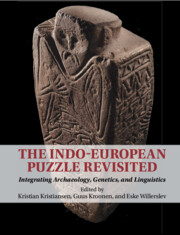Book contents
- The Indo-European Puzzle Revisited
- The Indo-European Puzzle Revisited
- Copyright page
- Contents
- Figures
- Tables
- Contributors
- Preface
- Introduction
- Part I Early Indo-European and the Origin of Pastoralism
- Part II Migratory Processes and Linguistic Dispersals between Yamnaya and the Corded Ware
- 5 The Corded Ware Complex in Europe in Light of Current Archaeogenetic and Environmental Evidence
- 6 Emergent Properties of the Corded Ware Culture: An Information Approach
- 7 Linguistic Phylogenetics and Words for Metals in Indo‑European
- 8 Word Mining: Metal Names and the Indo-European Dispersal
- Part III The Cultural and Linguistic Significance of Bell Beakers along the Atlantic Fringe
- Part IV The Bronze Age Chariot and Wool Horizons
- Part V Kinship Systems, Marriage, Fosterage, Free, and Unfree
- Concluding Reflections
- Index
- References
6 - Emergent Properties of the Corded Ware Culture: An Information Approach
from Part II - Migratory Processes and Linguistic Dispersals between Yamnaya and the Corded Ware
Published online by Cambridge University Press: 29 April 2023
- The Indo-European Puzzle Revisited
- The Indo-European Puzzle Revisited
- Copyright page
- Contents
- Figures
- Tables
- Contributors
- Preface
- Introduction
- Part I Early Indo-European and the Origin of Pastoralism
- Part II Migratory Processes and Linguistic Dispersals between Yamnaya and the Corded Ware
- 5 The Corded Ware Complex in Europe in Light of Current Archaeogenetic and Environmental Evidence
- 6 Emergent Properties of the Corded Ware Culture: An Information Approach
- 7 Linguistic Phylogenetics and Words for Metals in Indo‑European
- 8 Word Mining: Metal Names and the Indo-European Dispersal
- Part III The Cultural and Linguistic Significance of Bell Beakers along the Atlantic Fringe
- Part IV The Bronze Age Chariot and Wool Horizons
- Part V Kinship Systems, Marriage, Fosterage, Free, and Unfree
- Concluding Reflections
- Index
- References
Summary
How do virtually identical burial rituals and worldviews emerge among widely dispersed communities? Five thousand years ago, preliterate Corded Ware communities throughout Europe achieved this remarkable feat. For half a millennium, these communities performed near-identical burial rituals in an area that extends from the Volga to the Rhine. What processes shaped such durable uniformity?
- Type
- Chapter
- Information
- The Indo-European Puzzle RevisitedIntegrating Archaeology, Genetics, and Linguistics, pp. 81 - 92Publisher: Cambridge University PressPrint publication year: 2023



